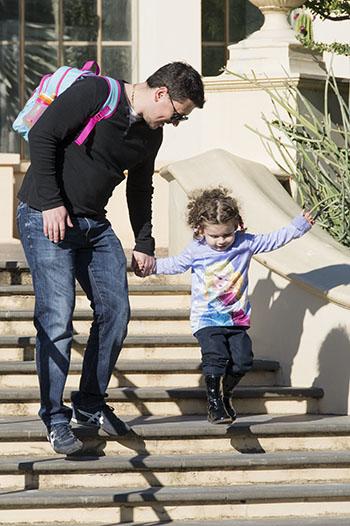Step up, step down
Duration/age

Will we go up? Will we go down? Can you jump from the top down to the ground?
Next time you are out and about and see some steps, encourage your child to climb them. As you help your child go up and down you could count how many steps there are or talk about which direction you are going.
Let’s start at the bottom of the steps and climb to the top.
There are 4 more steps till we reach the bottom.
As you climb up or down together talk about how your speed changes. Do you walk faster if there are only a few steps? Are you slower if there are lots of steep steps? Does it take you longer to walk up the stairs or down the stairs?
There are lots and lots of steps to walk up. We will need to walk slowly so we don’t get too tired.
There are only 3 small steps to walk down. I wonder if you can jump from the top step to the bottom?
Materials you will need
- Steps or a staircase
Alternative tools
- Low brick fence
- Garden bench
- Doorstep
Skills this activity improves
Why does this matter?
Encouraging your child to climb the stairs with you helps them to experience the different ways we can measure and explore space. You can measure by counting, talking about time and how long something will take. You can also measure by comparing the size of one thing to another.
"These stairs are much smaller than the ones at Grandma’s house."
As you talk about what you are doing your child will be hearing and following directions that involve position, direction and measurement.
Climbing and walking is a whole body activity that helps to develop muscle strength in the upper and lower body. Climbing up and down the stairs helps your child to develop an awareness of their body in space and to develop muscle tone and strength. As they move from one step to the next they are using their visual skills and senses to judge how close or far the next step is and where to place their foot and weight.
What does this lead to?
As your child climbs the stairs they’re using all of their body and senses. They are developing strength, control and coordination in all of their body parts including the large muscles in their trunk. Having a strong core, or trunk, is important as it helps children with good sitting posture. Good sitting posture is important for developing writing skills.
Encouraging your child to move and climb in different ways helps them to understand that they can use and move their bodies in many ways. As they explore the different ways their bodies move they are learning about measurement, space and size and how to move within and around objects.
Using language to compare and describe helps children to understand that there are different terms and tools we use to describe measurement. Measurement helps us to understand size and to successfully navigate around the environment. As children develop an understanding of size they begin to explore their space and to experiment with the variety of ways they can move their bodies and objects into, around and through space.
Language to use
- Up, down, sideways
- Ascend, descend
- top, bottom, middle, edge
- Steep, narrow, gradient, gradual, rise
- Start, finish
- High, low
- Straight, winding, curved, spiral
- Staircase, stairs, banisters, steps
- Step, climb, jump
Questions to use
- Where do you start when you climb a staircase?
- Can you only travel up or down a staircase?
- Can you climb down more than one step at a time?
- Which foot do you step with first?
- Do all staircases have the same sized steps?
Useful tips
- For more information on your child's physical development see the Child Health Record - the Blue Book.
- The Department of Health also has some hints and tips about physical activity for children aged 0 to 5.
- You might also like to take a look at the activities Balancing and Up, over, under, through.
- Remember to talk to your child in your home language.
More ideas
- Find some stepping stones that are different heights. Your child can use them to walk up and down.
- Time how fast your child can climb up and then down the ladder at the playground.
Variation by age
Birth to two year olds
- Set up an obstacle course with objects your baby can climb over.
- Start by climbing onto and off low objects. Gradually make the objects higher or wider.
Three to five year olds
- Make a list of the different objects you can climb onto and off.
- Time how fast you can get to the top of the stairs. Who is fastest in your family?
- Count how many stairs to the top or the bottom.
- Measure the width of different steps. Are they all the same or different?
Questions to ask
- Will we start at the top or the bottom?
- Can you step onto the bottom one?
Questions to ask
- Are there the same number of stairs when you go up as when you go down?
- Are all stairs the same size?
- Is the doorstep the same width as the step on a ladder?
Language to use
- Big, little, small
- High, tall, low
- Up, down
- Top, bottom
Language to use
- Big, little, small
- High, tall, low
- Up, down
- Top, bottom
- Width, depth, size


